

The World's Nuclear Reactors, October 2009. In a highly regulated society such as ours, it's very easy to get yourself in trouble with the law.
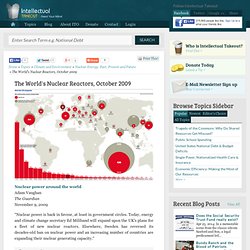
Learn more about how to protect yourself with the 5th Amendment and how to interact with the police. Know your rights with Flex Your Rights guide to the "10 Rules for Dealing with Police. " Looking for an internship? If so, Intellectual Takeout has an opportunity for you. We have plenty of work to do as well as ideas to spread, and we need your help to get it done. Curiously, not a few individuals are realizing that their education (K-12 and even college) neglected to provide them with as much understanding of the world as they would like.
Are you concerned your child isn't getting the education necessary to compete in the global economy or even, perhaps, to carry on the lessons and learning of Western Civilization? Sure, the idea of homeschooling is likely overwhelming. Let's face it, most of us love to watch TV and movies. Sadly (or happily for some), life goes on after college. Is the solution to the U.S. nuclear waste problem in France? Is the solution to the U.S. nuclear waste problem in France? Westinghouse AP1000. Reactor bolshoy moshchnosty kanalny. Appendix to Nuclear Power Reactors (Updated June 2010) The RBMK is an unusual reactor design, one of two to emerge in the Soviet Union in the 1970s.The design had several shortcomings, and was the design involved in the 1986 Chernobyl disaster.Major modifications have been made to RBMK reactors still operating.
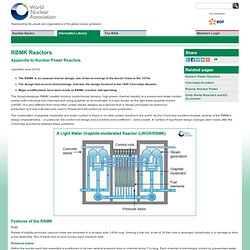
The Soviet-designed RBMK (reaktor bolshoy moshchnosty kanalny, high-power channel reactor) is a pressurised water-cooled reactor with individual fuel channels and using graphite as its moderator. It is also known as the light water graphite reactor (LWGR). It is very different from most other power reactor designs as it derived from a design principally for plutonium production and was intended and used in Russia for both plutonium and power production. Nuclear. The sun is basically a giant ball of hydrogen gas undergoing fusion into helium gas and giving off vast amounts of energy in the process.
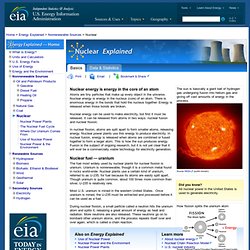
Did you know? All nuclear power in the United States is used to generate electricity. How fission splits the uranium atom Nuclear energy is energy in the core of an atom Atoms are tiny particles that make up every object in the universe. Nuclear energy can be used to make electricity, but first it must be released. In nuclear fission, atoms are split apart to form smaller atoms, releasing energy. Nuclear fuel — uranium. Boiling water reactor. The boiling water reactor (BWR) is a type of light water nuclear reactor used for the generation of electrical power.
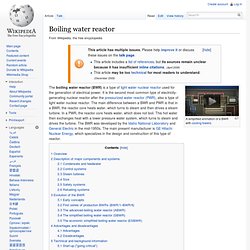
Uncertainty surrounds Japan's nuclear picture. 12 March 2011Last updated at 13:44 By Richard Black Environment correspondent, BBC News Police are trying to clear residents from the evacuation zone around the Fukushima plant The word "meltdown" goes to the heart of the big nuclear question - is nuclear power safe?
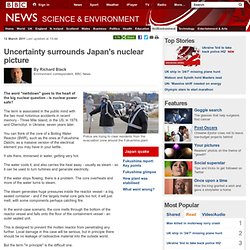
The term is associated in the public mind with the two most notorious accidents in recent memory - Three Mile Island, in the US, in 1979, and Chernobyl, in Ukraine, seven years later. You can think of the core of a Boiling Water Reactor (BWR), such as the ones at Fukushima Daiichi, as a massive version of the electrical element you may have in your kettle. It sits there, immersed in water, getting very hot. The water cools it, and also carries the heat away - usually as steam - so it can be used to turn turbines and generate electricity. A Conversation with My Dad, a Nuclear Engineer, about the Fukushima Daiichi Nuclear Power Plant Disaster in Japan.
Update: Improved audio soon to be available for all 4 interviews.
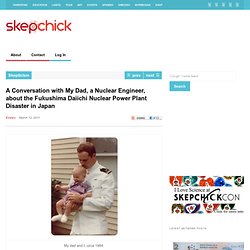
Please note that in the first interview my voice sounds strange because I used really bad recording software (free off the internet) that sped up my voice slightly and made it sound higher-pitched. I am not sure how to fix this, but please do not judge my voice until you have listened to the follow-up interviews. Yes, I have a high-pitched voice, but it’s not quite as bad as in the first interview. If my voice bothers you, please read the transcripts. Thanks! My dad does not usually swear. My dad- Commander Mark L. I hope to transcribe this conversation later, but for now here is the audio recording: Update: Transcription after the jump. Nuclear energy 101: Inside the "black box" of power plants. This morning, I got an email from a BoingBoing reader, who is one of the many people worried about the damaged nuclear reactors at Fukushima, Japan.
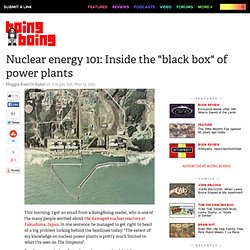
In one sentence, he managed to get right to heart of a big problem lurking behind the headlines today: "The extent of my knowledge on nuclear power plants is pretty much limited to what I've seen on The Simpsons". For the vast majority of people, nuclear power is a black box technology. Radioactive stuff goes in. Electricity (and nuclear waste) comes out. Somewhere in there, we're aware that explosions and meltdowns can happen.
As I write this, it's still not clear how bad, or how big, the problems at the Fukushima Daiichi power plant will be. At a basic level, nuclear energy isn't all that different from fossil fuel energy. A fission reaction is a lot like a table filled with Jenga games, each stack of blocks standing close to another stack. Every time one of those atoms breaks apart, it releases a little heat.